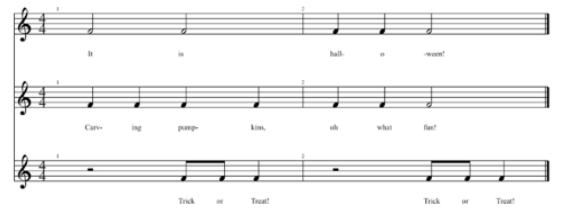Rhythm. Movement. Play. Success. Improvisation. Speech. These words, among others, encompass some of the key ideas behind Carl Orff’s philosophy of music education. Although the Orff approach was not created as a music therapy protocol, its core ideas of music, movement, rhythm, and improvisation are easily included in music therapy sessions (Darrow, 2008, p. 19). Orff methods are versatile, success-oriented techniques that can be used with music therapy populations across the lifespan.
Orff is a German approach to music education. Founder Carl Orff was interested in modern dance. In traditional ballet, music and movement were created separately; Orff wanted the music and movement to become one. Orff taught students how to create rhythm patterns using body percussion--snapping, clapping, patsching, and speech. After teaching the basics, Orff encouraged students to improvise over an ostinato rhythm pattern or drone (Ramsay, 2018, p. 9). Music Therapists use these Orff techniques in skilled music therapy settings to address therapeutic goals in both individual and group settings.
In the late 1920’s, Orff’s travels inspired him to incorporate unpitched percussion instruments, such as marimba and recorders, into his technique. These types of instruments came to be known as Orff Instruments and are essential to the technique. Combining instruments and movement, Orff would begin by teaching children rhythmic patterns using body percussion and then transfer these patterns to instruments (Ramsay, 2018, p. 10). The Orff method of teaching gained popularity throughout the 1940’s and 1950’s and is still common in American and European music education classrooms. In more recent years, the approach has been gaining popularity in music therapy training (Ramsay, 2018, p .9).
Orff provides clients opportunities to participate in multisensory interventions. These may be playing, singing, moving, or listening. This variety gives clients multiple areas to succeed and, in the group setting, can reach clients with different strengths (Schumacher, 2013, p. 113). In working with groups, Orff encourages individuals to be creative. The improvisation required by the Orff approach encourages clients to move out of their comfort zones together, as well as build relationships, trust, and rapport among the group (Schumacher, 2013, p. 113). Common interventions used with children include therapeutic singing, songwriting, music and movement, and instrument play. All of these interventions can incorporate Orff techniques (Orff, 1989).
A sample intervention is a structured instrument play. In a group setting, divide the group into three parts. Teach the first group rhythm number one by patsching (patting knees) and speaking the rhythm. Teach the second group rhythm number two by clapping and speaking the rhythm. Teach the third group rhythm number three by snapping the rhythm. Once the rhythms are successfully played on body percussion, transfer them to instruments. Review each rhythm with the instruments and give each group a chance to get comfortable with their rhythm before layering. Once all of the groups are comfortable playing their rhythms, signal certain groups to play softer and others to improvise over the background rhythms. This opportunity for variety and improvisation is fundamental to the Orff approach (Ramsay, 2018, p 9-11).
The following intervention is an example of this technique. Begin by dividing the group into three sections and assigning parts. The first group will play the top rhythm by patsching or patting their knees. The second group will play the second rhythm by clapping their hands. The final group will play the third rhythm by snapping their fingers. Have each group practice their part individually and then together. Then, begin layering the parts. Once all groups can successfully play their body percussion rhythms, transfer the rhythms. The first group will play their rhythm on drums, the second group will play rhythm sticks, and the third group, shakers. Again, have each group play their part independently before layering the rhythms and fading the verbal prompts.
This intervention addresses the following goals:
Auditory processing by discriminating different sounds
Social skills like cooperating in a group, listening to peers, impulse control, and attention
Motor planning to execute rhythm and play of instrument
Improving Expressive language by chanting words in rhythm
Orff techniques are simple and easily adaptable to multiple populations. Patients respond well to interventions that are based on the Orff theory of education given their activity-oriented nature. Although this approach is typically associated with music education, the Orff approach is growing in popularity amongst music therapists. Orff interventions are a valuable tool for the music therapist since they are so easily adaptable and comprehensible. It also provides structure for the clients in music therapy sessions while leaving plenty of room for improvisation and self-expression. This allows for patients to feel safe and supported in their music making, leading to them feeling more comfortable within the setting of a group and a session. Orff interventions are something that any population can engage in and enjoy, and are supported through both past and present research.
-Rachel Buchheit, Music Therapy Intern
References
Darrow, A., & American Music Therapy Association. (2008). Introduction to approaches in
music therapy (2nd ed.). Silver Spring, MD: American Music Therapy Association.
Schumacher, Karin. (2013). The importance of “Orff-Schulwerk” for musical social-integrative pedagogy and music therapy (English translation: Gloria Litwin). Approaches: Music Therapy & Special Music Education, 5(2), 113-118.
Orff, G. (1989). Key concepts in the Orff music therapy : Definitions and examples. London; New York: Schott.
Ramsay, S. (2018). Orff Schulwerk Certification Course: Level One Resource Book, 9-11.


